Fishing in a forest
A field of flooded trees can make for a largemouth oasis
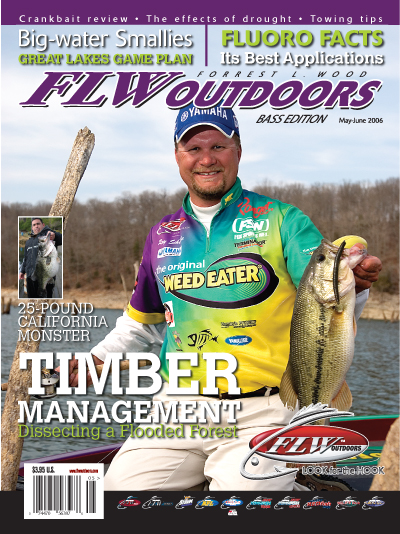
For bass anglers, the sight of a flooded forest is both exhilarating and intimidating. Bass could be anywhere on such a lake, or seemingly nowhere at all. Where do you begin? How do you isolate productive areas and eliminate unproductive ones?
Of course, anglers must answer the same questions wherever they fish.
One of the main secrets to fishing a forest is to put on some imaginary glasses that filter out the trees. Got ’em on? Good. Forget about the trees and imagine bare, open water. Timber certainly does concentrate fish, but on any lake or river, topographic features and contours determine which trees, or more importantly, which areas with trees, will hold the greatest concentrations of bass.
Anglers who discipline themselves to ignore what’s above water and concentrate on what’s underwater are always the most successful at mining big limits from woody waters.
Ray Scheide of Russellville, Ark., has enjoyed much success plucking fish from trees. His home water, Lake Dardanelle, sprawls over thousands of acres of old fields, pastures and woodlots. He also has a lot of experience on Lake Ouachita, site of the 2007 Forrest Wood Cup. Lake Ouachita doesn’t have much visible timber anymore, but it still has thousands of acres of standing timber below the surface. Both lakes are renowned bass factories, and trees are important fish-holding features at both. Determining which tree-studded areas provide the best cover is key to Scheide’s success.
In the springtime on Lake Dardanelle, or anywhere on the Arkansas River for that matter, trees are important spawning cover for largemouths. To find them, Scheide looks for a golden combination of wood, topography and substrate.
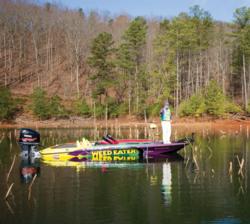 “There are a lot of dead laydowns on the backwaters and on the main river,” Scheide said. “Typically, bass are going to spawn right next to a deadfall. They want a bed location with warm water. But they also want a spot with a little bit of protection that is still easily accessible. In the springtime, that’s a real big deal, especially on the Arkansas River. Small creek pockets warm up the quickest. That’s when they like to get on isolated trees in flat pockets.”
“There are a lot of dead laydowns on the backwaters and on the main river,” Scheide said. “Typically, bass are going to spawn right next to a deadfall. They want a bed location with warm water. But they also want a spot with a little bit of protection that is still easily accessible. In the springtime, that’s a real big deal, especially on the Arkansas River. Small creek pockets warm up the quickest. That’s when they like to get on isolated trees in flat pockets.”
To catch those fish, many anglers traditionally spend a lot of time pitching soft-plastic baits to a nest hoping to get a reaction strike. Scheide is more subtle. Instead of pitching and flipping from several feet away, he makes long casts with a Senko.
“A straight, weightless worm is one of the deadliest baits to catch fish in that kind of cover,” Scheide explained. “Either that or a lizard with a 1/16-ounce bullet weight, something really light. I’m usually making a long cast, probably 20 yards. If you go right up to the tree, it can change the mood of that fish. I like making blind casts and just having faith that there is a fish on that tree. I work the tree over thoroughly, making multiple casts from different angles.”
On lakes with a lot of trees, Scheide looks for isolated wood. It’s a good feature to hit when you’re ready to increase the weight of your limit.
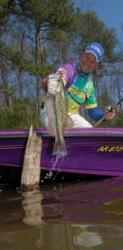 “Usually, on isolated wood, that’s where you catch your bigger fish for that body of water,” Scheide said. “A guy can run a bank for eight hours on Dardanelle without picking up his trolling motor and catch fish, but if he disciplines himself to fish something isolated, he’s going to catch more 3- to 6-pounders. It’s a real strong pattern.”
“Usually, on isolated wood, that’s where you catch your bigger fish for that body of water,” Scheide said. “A guy can run a bank for eight hours on Dardanelle without picking up his trolling motor and catch fish, but if he disciplines himself to fish something isolated, he’s going to catch more 3- to 6-pounders. It’s a real strong pattern.”
That’s a real strong pattern anywhere, including McGee Creek Lake, a tree-studded paradise in southeast Oklahoma that’s famous for trophy largemouths. Chuck Justice, a local guide, helped put that lake on the map by catching a long succession of largemouths weighing more than 10 pounds. I was with him one morning when he caught two 9-pounders in less than 40 minutes. His targets were very specific. He looked for small trios of cedar trees on submerged points where the base of the triangle pointed to deep water.
“That little triangle forms a protective pocket that shields a bass from the sides and from behind,” Justice explained. “It can get to deep water quickly if it needs to, but it can also face out and ambush anything that comes by.”
In that situation, one of the trees must have a low branch just above the water. Justice flips his jig over the branch and uses it as a fulcrum that allows him to whipsaw his jig up and down. That way, he can keep the jig in front of a bass for as long as it takes to provoke it to bite with only one cast. It works extraordinarily well.
Many popular lakes in southern Arkansas and northern Louisiana are famous for standing timber. Lake Millwood is a notable example in Arkansas. In Louisiana, you’ve got the Red River and its assorted backwaters, as well as lakes Caddo, Bistineau and Toledo Bend. It’s daunting when you see all that standing timber on your first visit to those waters, but when you remember that bass relate to current, water temperature, bottom contours and food, you can methodically isolate productive areas.
The Red River from Shreveport to Alexandria has a vast network of sloughs, oxbows and backwaters that provide an endless array of fishing targets. During high-water periods in late winter and early spring, the water surges over the landscape and can triple the amount of fishable areas. This also disperses bass over large areas, but if you find choke points in the woods that funnel current, you’ll almost always find bass.
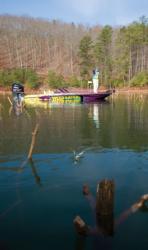 Anglers discovered a textbook example of this at the Wal-Mart FLW Tour event on the Ouachita River in 2005, when they struck gold in the flooded hardwoods of Felsenthal National Wildlife Refuge.
Anglers discovered a textbook example of this at the Wal-Mart FLW Tour event on the Ouachita River in 2005, when they struck gold in the flooded hardwoods of Felsenthal National Wildlife Refuge.
“Felsenthal is one of the great hidden wonders of the world,” Scheide said reverently. “There’re lots of ditches and cypress forests mixed with grass. What I look for in a place like that, that’s choked with cypress trees, is where you have a little creek channel that opens into a small bayou. It might be a half-mile long and a couple hundred yards wide. It squeezes down, and it might be another mile or two until you come to another open area.
“Those areas have flow in them, and I concentrate on the neck-downs. Wherever that lake narrows down, the current is concentrated, and it positions fish better. I’ve seen that over and over, when those neck-downs win tournaments.”
In the backwaters of the Red River, you’ll often see big rafts of floating trees. These rafts can cover several acres. They’re virtually impenetrable, but they’re not unfishable. The water beneath the rafts teems with shad and invertebrates, so they also hold large concentrations of big largemouths.
While fishing with a Shreveport, La., native one day, we encountered log rafts amid the flooded timber in two different backwaters. He looked for gaps in the rafts and pitched soft-plastic worms into holes the size of bread pans. It was tedious at times, but when a bass hit, it was always between 3 and 5 pounds.
I saw this pattern repeated on Fontana Lake, a nearly sterile reservoir that straddles the Tennessee-North Carolina line. This deep, rocky, gin-clear lake is known almost exclusively for walleyes, as well as its autumn topwater smallmouth bite. You’ll almost never hear it mentioned in the same sentence with largemouths.
While fishing there with guide Danny Brower of Sylva, N.C., we encountered a giant raft of floating timber at the mouth of the Little Tennessee River. We were on one side of it, and another boat was on the other. Giant schools of minnows swarmed at the edges of the raft, and beneath we could clearly see largemouths in the 5- to 8-pound range. Brower and I weren’t equipped for that kind of fishing, but the anglers in the other boat caught a couple of 7-pounders fishing through gaps in the raft.
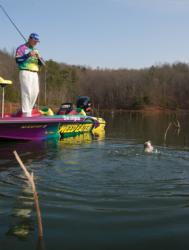 Even trickier than fishing visible timber is fishing submerged timber. In many lakes, such as Ouachita and Beaver, the treetops long ago broke off and floated away, but the trunks still stand. Keith Pace of Monticello, Ark., who finished third at the 2006 FLW Tour event at Lake Okeechobee, said if you can find that golden combination of current, food, contour and depth variation, you’ll find spots where you can consistently win tournaments.
Even trickier than fishing visible timber is fishing submerged timber. In many lakes, such as Ouachita and Beaver, the treetops long ago broke off and floated away, but the trunks still stand. Keith Pace of Monticello, Ark., who finished third at the 2006 FLW Tour event at Lake Okeechobee, said if you can find that golden combination of current, food, contour and depth variation, you’ll find spots where you can consistently win tournaments.
“I look for drops or ridges or a creek channel within the trees,” Pace said. “You can kind of tell by looking whether a creek channel runs through it. When you find the fish, you’ll usually find a bunch of them gathered together. Something is keeping them there, and when you figure out what that is, you look for it in other places. It’s a sweet spot in the standing timber.”
That strategy applies wherever you find trees, Pace added.
“Timber fishing is pretty much the same everywhere you go,” he said. “There may be different kinds of trees from one lake to another, but I look for the same thing anywhere I go.”
Timber `cutters’
When fishing timber, Ray Scheide uses a 7-foot, 5-inch rod mated to a reel with a 6.2:1 retrieve ratio. He also uses fluorocarbon line.
The heart of his electronics package is a Lowrance 332c. Equipped with a GPS, it allows him to pinpoint sweet spots in the timber.
Keith Pace uses a 7-foot, 6-inch flipping stick – also matched with a 6.2:1 ratio reel – as well as 20- to 25-pound-test mono.
Chuck Justice also uses stiff rods mated with 7.1:1-retrieve-ratio reels.
These anglers demand fast reels and big sticks because it’s essential to get big fish away from thick cover as soon as you set the hook.
Forest fighters
When fishing submerged timber, Ray Scheide tries to locate bass with a square-billed crankbait. His favorite is the Norman Fat Boy in the splatterback pattern.
“When I cast that square-bill down a barren bank, I find hidden stuff, like stumpfields and submerged brush piles. Spring through fall, that’s one of my favorite ways to fish,” Scheide said.
When he finds fish, he slows down and fishes more deliberately with a jig or soft plastic.
“Typically bass do like the square-bill, but if I find brush and don’t get bit, I switch to a Terminator 3/8-ounce jig. That’s my top-secret jig,” Scheide said. “If it’s more into summer or deep summer, I switch to an 8- to 10-inch plastic worm. In spring and fall, I really prefer a green-pumpkin jig. I tip it with a Zoom Speed Craw.”